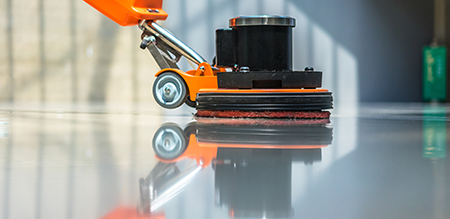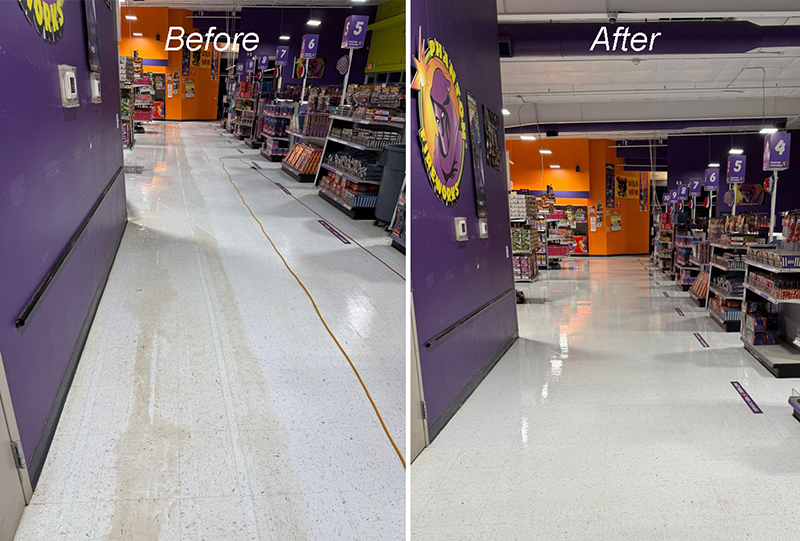In commercial buildings, floors are more than just a surface. They’re a critical asset that shapes first impressions, ensures safety, and withstands relentless wear. From bustling office lobbies to retail showrooms and industrial warehouses, floors endure heavy foot traffic, equipment movement, and spills. Over time, even the most durable materials—concrete, tile, or vinyl—can turn dull and worn. As a result, this will diminish a business’s professional image. Sealing and waxing offer a transformative solution, restoring shine, enhancing durability, and reducing maintenance costs. This post explores how these processes revitalize commercial floors, their specific benefits in high-traffic settings, and practical strategies to achieve a dazzling, long-lasting finish.
The Role of Sealing and Waxing in Commercial Spaces
Sealing involves applying a protective coating that shields a floor’s surface from moisture, chemicals, and physical damage. In commercial environments, because spills and heavy use are common, sealants act as a barrier, preserving materials like concrete’s structural integrity or tile’s pristine appearance. Waxing adds a glossy topcoat that enhances visual appeal and serves as a sacrificial layer, absorbing scratches and scuffs before they reach the floor itself. For businesses, this combination is a powerful tool to maintain a polished look while protecting a significant investment.
Why Sealing and Waxing Are Essential for Commercial Floors
Commercial floors face unique challenges—high foot traffic, rolling carts, and exposure to dirt or chemicals. Without proper care, they can quickly degrade, leading to costly repairs or replacements. Here’s why sealing and waxing are non-negotiable for businesses:
1. Enhanced Durability for High-Traffic Areas
In commercial settings, floors endure constant stress. Sealing prevents damage from penetrating deep into the material, such as water seeping into concrete or stains embedding in tile grout. Waxing adds a protective layer that absorbs surface-level wear, reducing the risk of permanent scratches or scuffs. This dual approach extends floor lifespan, critical for spaces like retail stores or office buildings where downtime for repairs disrupts operations.
2. Professional Aesthetic Appeal
A well-maintained floor reflects a business’s attention to detail and professionalism. Dull, scratched floors can deter customers or undermine employee morale. But, a glossy, sealed surface creates a welcoming, high-end atmosphere. Waxing amplifies this effect with a mirror-like shine, making spaces like lobbies or showrooms stand out. For example, a sealed and waxed concrete floor in a warehouse can look sleek and modern, while polished vinyl in an office elevates the workspace.
3. Simplified Maintenance and Cleaning
Commercial floors must be cleaned frequently, often daily, to maintain hygiene and appearance. Sealed and waxed surfaces repel dirt, dust, and spills, making routine cleaning faster and more effective. In a busy restaurant, for instance, a sealed tile floor resists grease stains, while wax ensures quick wipe-downs restore the shine. This reduces labor costs and the need for harsh cleaning chemicals, benefiting both budgets and the environment.
4. Cost Savings Over Time
Replacing or refinishing commercial floors is expensive and disruptive. Sealing and waxing are proactive measures that prevent damage, minimizing the need for major repairs. For example, a properly sealed concrete floor in a warehouse can resist chemical spills, while regular waxing prevents surface wear in a retail store. These treatments are a fraction of the cost of floor replacement, offering significant savings for businesses.

The Transformation Process for Commercial Floors
Transforming commercial floors from dull to dazzling requires a systematic approach tailored to high-traffic environments. Here’s how businesses can achieve optimal results:
Step 1: Assess and Prepare
Begin by evaluating the floor’s condition and material—concrete, vinyl, tile, or terrazzo. Identify signs of wear, such as scratches, stains, or faded finishes. Thoroughly clean the floor to remove dirt and grease. Strip the old wax. Use industrial-grade cleaners suited to the floor type. In commercial settings, professional cleaning equipment like auto-scrubbers may be necessary to ensure a spotless surface. Allow the floor to dry completely before proceeding.
Step 2: Apply the Right Sealant
Choose a sealant designed for commercial use and compatible with the floor material. For concrete, epoxy or acrylic sealants provide robust protection against heavy loads and chemicals. Vinyl floors benefit from acrylic sealants, while tiles may require penetrating sealants for porous surfaces or grout-specific products. Apply the sealant evenly using professional tools like rollers or sprayers, working in sections to avoid overlap marks. Drying times vary—typically 24–48 hours—so plan applications during off-hours to minimize disruption.
Step 3: Wax for Protection and Shine
Once the sealant is dry, apply a commercial-grade wax suited to the floor type, such as liquid wax for vinyl or high-gloss wax for concrete. Use a floor buffer or applicator to spread thin, even layers, ensuring a streak-free finish. Multiple coats may be needed for high-traffic areas to achieve maximum durability and shine. Buff between coats for a polished look, and allow the wax to cure fully—usually 4–8 hours—before reopening the space.
Step 4: Maintain the Finish
Regular maintenance is critical in commercial settings. Daily sweeping or vacuuming prevents dirt from scratching the wax layer. Use auto-scrubbers or damp mops with neutral cleaners for deeper cleaning. Reapply wax every 1–3 months in high-traffic areas like lobbies or retail floors, and every 6–12 months in less-trafficked spaces like offices. Reseal every 1–2 years, depending on wear, to maintain the protective barrier. A maintenance schedule tailored to your business’s needs ensures consistent results. The Cleaning Supply Mart recommends using mats and rugs to minimize wear.
Tailoring to Commercial Floor Types
Different commercial floors require specific sealing and waxing approaches:
- Concrete: Common in warehouses and retail spaces, concrete benefits from epoxy sealants for chemical resistance and high-gloss waxes for a sleek finish. Regular waxing prevents pitting from heavy equipment.
- Vinyl: Widely used in offices and healthcare facilities, vinyl requires acrylic sealants and waxes to maintain flexibility and shine. Frequent waxing is ideal for high-traffic corridors.
- Tile: Found in restaurants and lobbies, ceramic or porcelain tiles need penetrating sealants for grout and optional wax for unglazed surfaces to enhance shine and stain resistance.
- Terrazzo: Popular in upscale commercial spaces, terrazzo requires specialized sealants and waxes to preserve its intricate patterns and glossy finish.
Consult product specifications or a flooring expert to ensure compatibility and performance.
Avoiding Common Pitfalls
To achieve a dazzling commercial floor, avoid these mistakes:
- Inadequate Cleaning: Residual dirt or grease can cause uneven sealant or wax application, leading to a patchy finish.
- Using Incorrect Products: Mismatched sealants or waxes can damage floors or fail to adhere, wasting time and money.
- Overapplying Products: Thick layers of sealant or wax can create a sticky, cloudy surface. Apply thin, even coats for best results.
- Neglecting Maintenance: Skipping regular waxing or resealing allows damage to accumulate, undermining the floor’s appearance and durability.
The Value of Professional Services
While small businesses may handle basic sealing and waxing in-house, large commercial spaces benefit from professional services. Flooring experts use industrial equipment, like high-speed buffers and auto-scrubbers, to achieve uniform results quickly. They can also assess traffic patterns and recommend customized maintenance schedules, ensuring minimal disruption to business operations. For high-stakes environments like retail or hospitality, professional expertise guarantees a flawless, durable finish that impresses clients and customers.
The Dazzling Impact on Your Business
Sealing and waxing transform commercial floors from dull to dazzling, enhancing the professional image of your business while protecting a valuable asset. A gleaming lobby welcomes clients, a polished retail floor attracts shoppers, and a durable warehouse floor supports efficient operations. By investing in these treatments, businesses save on repair costs, simplify maintenance, and create a safer, more inviting environment.
To get started, assess your floors’ needs, select high-quality products, and consider professional services for large or complex spaces. With a consistent maintenance plan, your commercial floors will shine brightly, reflecting your commitment to quality and leaving a lasting impression.
